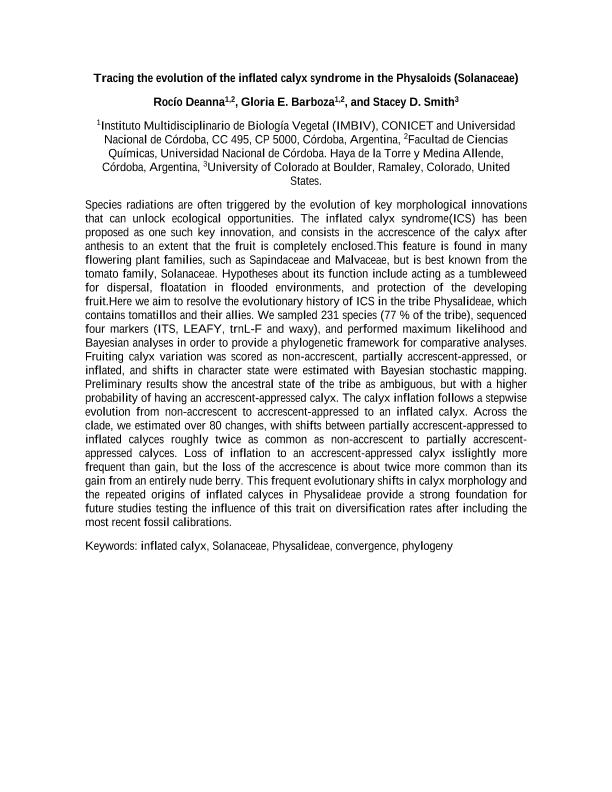Evento
Tracing the evolution of the inflated calyx syndrome in the Physaloids (Solanaceae)
Tipo del evento:
Conferencia
Nombre del evento:
Botany 2018: Thriving with Diversity
Fecha del evento:
21/07/2018
Institución Organizadora:
Botanical Society of America;
Editorial:
Botanical Society of America
Idioma:
Inglés
Clasificación temática:
Resumen
Species radiations are often triggered by the evolution of key morphological innovations that can unlock ecological opportunities. The inflated calyx syndrome(ICS) has been proposed as one such key innovation, and consists in the accrescence of the calyx after anthesis to an extent that the fruit is completely enclosed.This feature is found in many flowering plant families, such as Sapindaceae and Malvaceae, but is best known from the tomato family, Solanaceae. Hypotheses about its function include acting as a tumbleweed for dispersal, floatation in flooded environments, and protection of the developing fruit.Here we aim to resolve the evolutionary history of ICS in the tribe Physalideae, which contains tomatillos and their allies. We sampled 231 species (77 % of the tribe), sequenced four markers (ITS, LEAFY, trnL-F and waxy), and performed maximum likelihood and Bayesian analyses in order to provide a phylogenetic framework for comparative analyses. Fruiting calyx variation was scored as non-accrescent, partially accrescent-appressed, or inflated, and shifts in character state were estimated with Bayesian stochastic mapping. Preliminary results show the ancestral state of the tribe as ambiguous, but with a higher probability of having an accrescent-appressed calyx. The calyx inflation follows a stepwise evolution from non-accrescent to accrescent-appressed to an inflated calyx. Across the clade, we estimated over 80 changes, with shifts between partially accrescent-appressed to inflated calyces roughly twice as common as non-accrescent to partially accrescent-appressed calyces. Loss of inflation to an accrescent-appressed calyx isslightly more frequent than gain, but the loss of the accrescence is about twice more common than its gain from an entirely nude berry. This frequent evolutionary shifts in calyx morphology and the repeated origins of inflated calyces in Physalideae provide a strong foundation for future studies testing the influence of this trait on diversification rates after including the most recent fossil calibrations.
Palabras clave:
INFLATED CALYX
,
SOLANACEAE
,
PHYSALIDEAE
,
CONVERGENCE
Archivos asociados
Licencia
Identificadores
Colecciones
Eventos(IMBIV)
Eventos de INST.MULTIDISCIPL.DE BIOLOGIA VEGETAL (P)
Eventos de INST.MULTIDISCIPL.DE BIOLOGIA VEGETAL (P)
Citación
Tracing the evolution of the inflated calyx syndrome in the Physaloids (Solanaceae); Botany 2018: Thriving with Diversity; Rochester; Estados Unidos; 2018; 1-1
Compartir




